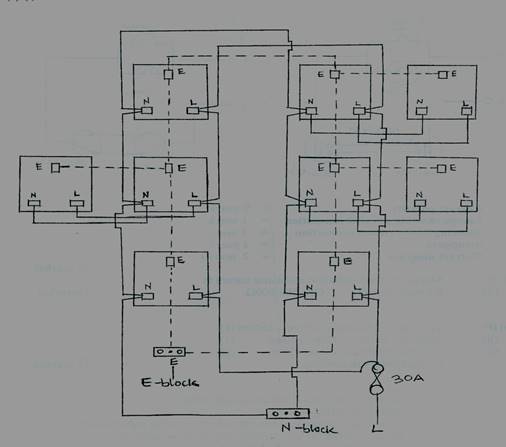This question test the candidates’ knowledge on practical. Majority of the candidates that attempted this question did not do well in the areas of ring circuits and sockets. However, some candidates performed very well in questions involving systems and causes of lamp defects.
The expected answers include:
5 (a) (i)

(ii) 30A
(iii) 3 x 2.5mm2 accept 2.5mm2
(iv) Total sockets divided by three
OR Total sockets OR 1 of the total number of sockets
3 3
(b) (i) Domestic ring circuit is defined in the IEE regulations as
a final sub-circuit in which the current – carrying and earth-
continuity conductors are connected in a form of a loop, both ends
of which are connected to a single way in a distribution fuse board
or its equivalent.
(ii) - Minimum cross-sectional area of 2.5mm2 for P.V.C or T.R.S. cable.
- Unlimited number of socket outlets allowed for floor area under 100m2.
- Spurs should not be more than half the number of socket outlets
on the ring circuit.
- Fixed appliances must be protected by a local fuse
- Fused 13A plug should be used at sockets outlets supplying
portable appliances
- 30A fuse should be used to protect the ring circuit.
(c) Faults in fluorescent lamp circuit
S/N |
SYMPTOM |
POSSIBLE CAUSE |
(i) |
Fused blows when lamp is switched on |
Short circuit in the wiring |
(ii) |
Lamp appears dead when switched on |
No power supply/broken tube
electrode/faulty starter/dead tube/dead choke |
(iii) |
Lamp makes repeated effort to start |
Aging lamp/low voltage/faulty starter |
(iv) |
Lamp does not light but electrodes glow continuously |
Faulty starter/faulty (R.I.S.)
capacitor/aging tube/low voltage |
(d)(i) To improve power factor (output) of the lamp
To suppress radio frequency interference
(ii) It strikes immediately it is switched on
It has warning effect
It is very bright
|



